Soltek Xabre 600 Video Card Review
|

CONTENTS
-
General
information
-
Video
card features
-
Test
system configuration
-
Test
results: news about Xabre architecture, 3Digest summary
-
Conclusion
Spring 2003 is promising to bring new names, new sensations and new
disappointments regarding ATI's and NVIDIA's 3D accelerators. I suppose
when this review is published, a couple of new products will be already
announced.
But what about the old heroes? While GeForce4 MX, RADEON 9000 was scrutinized
inside out, SIS Xabre got much less attention. Why? First of all, there
are few manufacturers dealing with Xabre because of its drawbacks (no anisotropic
filtering, slow and often wrong AA, turbotexturing which makes the card
as fast as GeForce4 MX 440 and RADEON 9000 but deteriorates 3D image quality
and causes significant slowdown when this mode is off (lower than acceptable
in 2002-2003). Secondly, many just don't want to find fault with NVIDIA
and ATI, that is why some companies didn't even start making such cards,
and some only kicked off the production and then quickly phase it out (ASUS,
Gigabyte).
Is Xabre really that bad? The market offers already 4 GPU types: Xabre80,
Xabre200, Xabre400 and Xabre600. By the way, you can get more detailed
information on performance of this line in our previous reviews:
Theoretical materials and reviews related to SIS Xabre GPU
features and functionality
Line:
-
Xabre 80 - AGP4x, 200/166 MHz (core/memory) SDR 128 bit
-
Xabre 200 - AGP8x, 200/166 MHz (core/memory) DDR 128 bit
-
Xabre 400 - AGP8x, 250/250 MHz (core/memory) DDR 128 bit
-
Xabre 600 - AGP8x, 300/300 MHz (core/memory) DDR 128 bit
Well, the family seems to be covering all clock speeds so that everyone
should feel satisfied with the offer. Let's see what's we have at www.xabre.com:
Ultra performance 256-bit engine
-
4 pixel programmable rendering pipelines and 8 texture units
-
Peak polygon rate: 30M polygon/sec @ 1 pixel/polygon with Gouraud shaded,
point -sampled, linear and bilinear texture mapping
-
Peak fill rate: 1200 M pixel/sec, 2400 M texture/sec @ 10,000 pixel/polygon
with Gouraud shaded and two bilinear textured
So, it comes with 4 pipelines with 2 texture units on each, plus 300 MHz frequency.
It's very close GeForce4 Ti 4600. But our test shows that Xabre600 works much
slower than NVIDIA's baby (you can check it in the reviews listed above and 3Digest)
Last time we pointed out that the developers saved on transistors in
the die for caches and provided no proper memory optimization technologies.
However, you will see that Xabre has a bit different characteristics than
SIS specifies in the new synthetic tests from RightMark 3D and fillrate
tests from 3DMark03.
Still, is it worth buying such cards? Well, SIS does pay due attention
to drivers debugging. And complains, if any, are not fatal. If the prices
match their performance and the range of 3D functions supported (also remember
that SIS had ill fame for a long time as a chip & card maker), they
will get a good chance to succeed.
Soltek is a well-known Taiwanese manufacturer that gained authority
on our local market, and the graphics cards we tested before showed high
quality and had solid accessory packs bundled.
Card
| Soltek Xabre 600 |
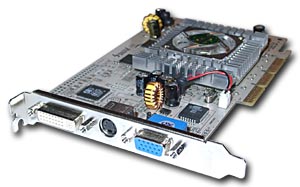
|

|
| Soltek Xabre 600 |
| AGP X2/4/8 interface, 64 MB DDR SDRAM in 4 chips on the PCB's right
side. 128bit memory interface.
EtronTech memory, 3.3ns access time which corresponds to 300 (600) MHz.
Memory works at this very clock speed, while the core operates at 300 MHz
which is standard for Xabre 600. |

|
| Comparison with the reference design, front view |
| Soltek Xabre 600 |
Reference card SIS Xabre 600 |

|
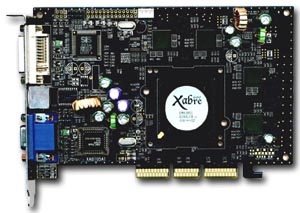
|
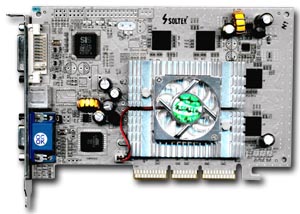
|
| Comparison with the reference design, back view |
| Soltek Xabre 600 |
Reference card SIS Xabre 600 |
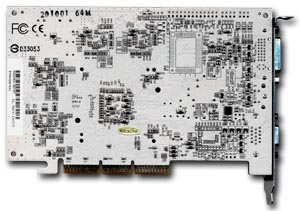
|

|
|
Soltek uses the reference design. The PCB is not covered with silver,
as you may think comparing it with Triplex's products; it's simply white
varnish:
Soltek Xabre 600
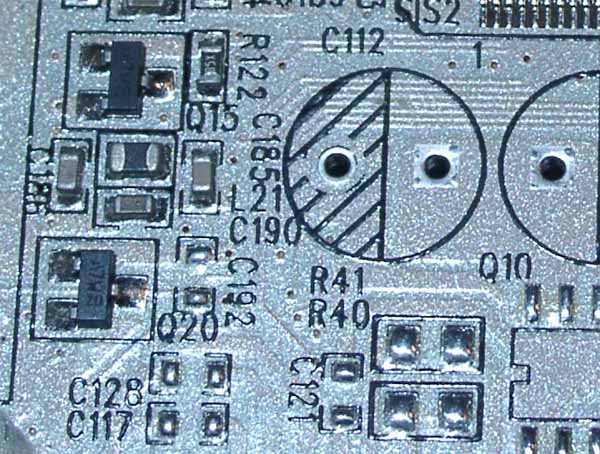
Triplex GeForce 4 Ti 4800SE
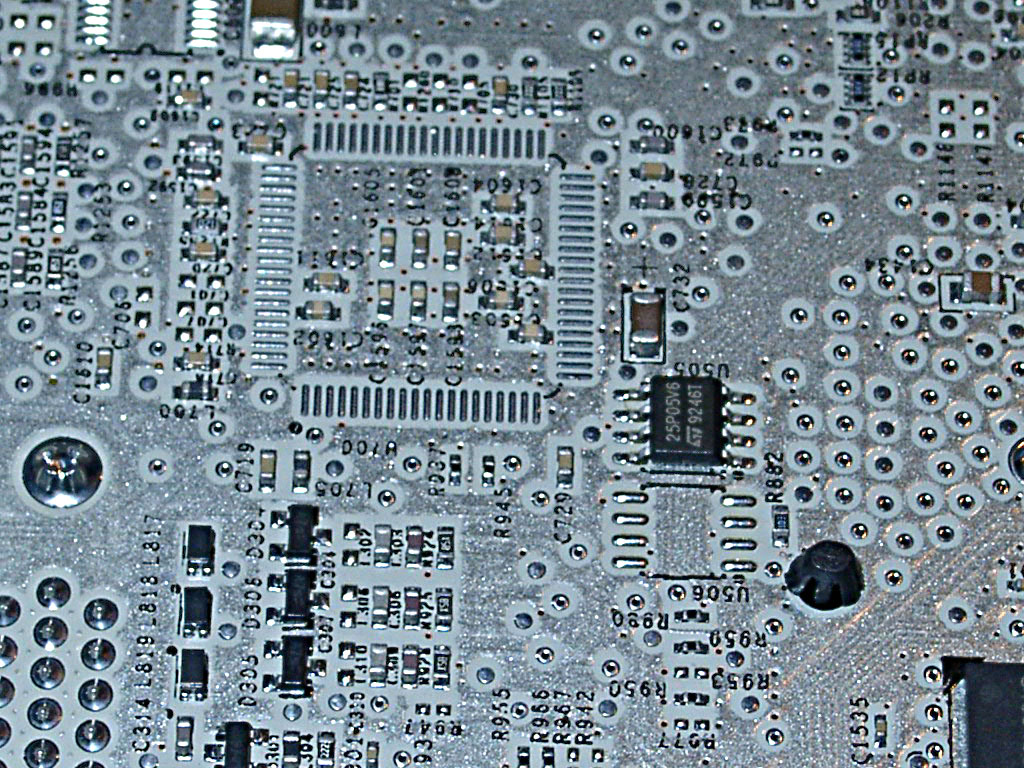
The silver-coated PCB of the Triplex card has proper isolation
from the logic elements. The Soltek's card doesn't have such.
Now have a look at the cooler.
| Soltek Xabre 600 |
| It's an ordinary heatsink with a fan in the center. The heatsink's
color excellently matches with the PCB. |

|
| If we take off the cooler, we can see the processor itself.
Soltek Xabre 600
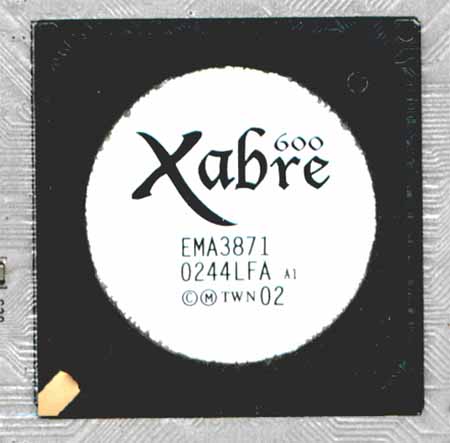
The package contents:
|
| Soltek Xabre 600 |
| User Guide, CD with drivers and utilities, S-Video-to-RCA adapter and
TV-out extenders. |

|
| The card ships in retail package. |
| Soltek Xabre 600 |
| The designers at Soltek created a stylish and bright box. |

|
Overclocking
| Soltek Xabre 600 |
300/600 -> 340/620 MHz |
Note that
-
Overclocking requires additional card cooling (for its memory, in particular):

-
Overclocking depends on a certain sample, and you shouldn't extend single-card
results to the entire series or trade mark. Overclocking results are not
obligatory characteristics of video cards.
Testbeds and drivers
Testbeds:
-
Pentium 4 3066 MHz based computer:
-
Intel Pentium 4 3066 MHz;
-
ASUS P4G8X (iE7205) mainboard;
-
1024 MB DDR SDRAM;
-
Seagate Barracuda IV 40GB HDD;
-
Windows XP SP1;
-
ViewSonic P810 (21") and ViewSonic P817 (21")
monitors.
-
ATI v6.255 drivers.
-
Athlon XP 2600+ based computer:
-
AMD Athlon XP 2600+ (2133 MHz);
-
EPoX (nForce2) mainboard;
-
1024 MB DDR SDRAM PC3200;
-
Seagate Barracuda IV 40GB HDD:
-
Windows XP SP1;
-
ViewSonic P810 (21") and ViewSonic P817 (21")
monitors.
VSync off in drivers, texture compression off in applications. Default
texture detail (TurboTexturing=3).
Test results
Before we start examining 2D quality, I should say there are no complete
techniques for objective 2D quality estimation because:
-
2D quality much depends on certain samples for almost all modern 3D accelerators;
-
Besides videocards, 2D quality depends on monitors and cables;
-
Moreover, certain monitors might not work properly with certain video cards.
As for the sample tested, together with the ViewSonic P817 monitor and
BNC Bargo cable it showed excellent quality at the following resolutions
and clock speeds:
| Soltek Xabre 600 |
1600x1200x75Hz (satisfactory), 1280x1024x100Hz, 1024x768x100Hz |
Test Results: RightMark3D synthetic tests and, unexpectedly, 2 rendering
pipelines instead of 4
The rumors spreading over the Net got it that Xabre doesn't have 4 pipelines.
To check it I used Pixel
Filling test from RightMark3D (the packet is described in-depth in GeForce
FX Review)
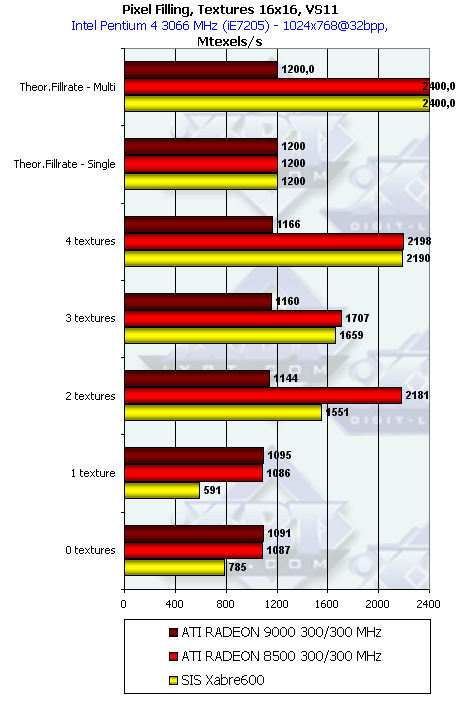
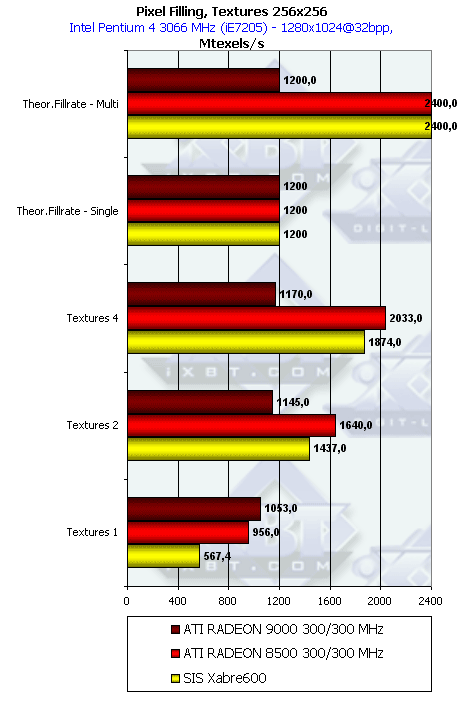
In both texture combinations the fillrate in the single texturing mode
is about 600 Mtexel/s. It's twice lower than the theoretical peak of 1200
Mtexels.
We also checked it with the Fillrate benchmark from 3DMark03:

It's all the same here. Note that the test proves the support of 8 texture
units though the actual fill rate is far lower than the peak speed of 2400
Mtexel/s.
Thus, Xabre has 2 pipelines with 4 texture units on each. It proves
that Xabre is designed for operation only with 4 textures. It probably
explains why Xabre600 yields to GeForce4 Ti, though they should go on a
par according to the specs. Games using 4 textures are few on the market,
and half of the texture units simply stand idle.
Unfortunately, 3DMark03 doesn't support operation in 16bit color, and
RightMark doesn't account for this anachronism, that is why it's impossible
to test Xabre600 in these benchmarks in 16bit color. But the guys from
fcenter.ru give the fillrate diagrams in 16bit color, and the scores are
only a trifle higher than in 32bit color.
3Digest Test Results
Test applications:
-
Return to Castle Wolfenstein (MultiPlayer) (id Software/Activision) - OpenGL,
multitexturing, Checkpoint-demo,
maximum test settings, S3TC OFF, the configs are available here
-
Serious Sam: The Second Encounter v.1.05 (Croteam/GodGames) - OpenGL, multitexturing,
Grand Cathedral demo, test settings: quality, S3TC OFF
-
Codecreatures Benchmark Pro (Codecult) - Direct3D, Shaders, Hardware T&L,
Dot3, cube texturing, highest quality
-
Unreal Tournament 2003 Demo v.1077 (Final Release) (Digital Extreme/Epic
Games) - Direct3D, Vertex Shaders, Hardware T&L, Dot3, cube texturing,
default quality
-
3DMark2001 SE Pro (MadOnion/Remedy), Game2 "Dragothic" - DirectX
8.0, Hardware TCL, multitexturing, LOW Details, DXTC
OFF, double buffering, 24-bit Z buffer
-
3DMark2001 Pro (MadOnion/Remedy) - DirectX 8.0, Hardware
TCL, Game1, Game2, Game3, Game4, Low, High detail levels
-
RightMark 3D (one of the game scenes) - DirectX 8.1, Dot3, cube texturing,
shadow buffers, vertex and pixel shaders (1.1, 1.4).
January 2003 summary diagrams of videocards performance with latest drivers
Overclocked cards are marked red, clock speeds follow the 'o/c' sign.
For the summary diagrams we used drivers v42.01 for NVIDIA cards,
v6.255 - for ATI cards, v3.07 for SIS cards and v1.03.00.043 for Matrox
cards.
-
1. Return to Castle Wolfenstein -
-
2. Unreal Tournament 2003 DEMO -
-
3. Codecreatures Benchmark Pro
-
4. 3DMark2001, Game2 Low Details (Dragothic)
-
5. Serious Sam: The Second Encounter
-
6. 3DMark2001
-
6.1. 3DMark2001 standard tests
-
Windows
XP (January 2003)
-
Tests
on Pentium 4 3066 MHz, 1024x768, 3D Marks
-
Tests
on Pentium 4 3066 MHz, 1024x768, Game1 Low
-
Tests
on Pentium 4 3066 MHz, 1024x768, Game1 High
-
Tests
on Pentium 4 3066 MHz, 1024x768, Game2 Low
-
Tests
on Pentium 4 3066 MHz, 1024x768, Game2 High
-
Tests
on Pentium 4 3066 MHz, 1024x768, Game3 Low
-
Tests
on Pentium 4 3066 MHz, 1024x768, Game3 High
-
Tests
on Pentium 4 3066 MHz, 1024x768, Game4
-
Tests
on Pentium 4 3066 MHz, 1280x1024, 3D Marks
-
Tests
on Pentium 4 3066 MHz, 1280x1024, Game1 Low
-
Tests
on Pentium 4 3066 MHz, 1280x1024, Game1 High
-
Tests
on Pentium 4 3066 MHz, 1280x1024, Game2 Low
-
Tests
on Pentium 4 3066 MHz, 1280x1024, Game2 High
-
Tests
on Pentium 4 3066 MHz, 1280x1024, Game3 Low
-
Tests
on Pentium 4 3066 MHz, 1280x1024, Game3 High
-
Tests
on Pentium 4 3066 MHz, 1280x1024, Game4
-
Tests
on Pentium 4 3066 MHz, 1600x1200, 3D Marks
-
Tests
on Pentium 4 3066 MHz, 1600x1200, Game1 Low
-
Tests
on Pentium 4 3066 MHz, 1600x1200, Game1 High
-
Tests
on Pentium 4 3066 MHz, 1600x1200, Game2 Low
-
Tests
on Pentium 4 3066 MHz, 1600x1200, Game2 High
-
Tests
on Pentium 4 3066 MHz, 1600x1200, Game3 Low
-
Tests
on Pentium 4 3066 MHz, 1600x1200, Game3 High
-
Tests
on Pentium 4 3066 MHz, 1600x1200, Game4
-
7. RightMark 3D
In closing I should say that the card showed perfect stability and quality.
Operation of TV-out with the SIS 301 coprocessor was estimated earlier
and you can find the results in the reviews listed above.
Conclusion
This production Xabre600 based card is one of the first solutions on the
SIS new-comer. I have no complains about it, - Soltek made a really high-grade
product.
Our 3Digest clearly shows all weak points of Xabre; first of all, it
has artifacts in AA mode in some games with the latest drivers (which didn't
have place before). Besides, it doesn't have anisotropy support and demonstrated
inferior quality with the default texturing. If you set higher quality,
the speed gain will be brought to zero. Well, only price cuts can now attract
attention to such products.
Finally, Xabre doesn't have any 4 pipelines. There are only two. Maybe,
the processor supports pipeline programming but I doubt that such expensive
technologies would be integrated in this budget solution. Most likely,
the Xabre's actual formula is 2x4.
Highs:
-
Good performance in 3D;
-
Excellent built quality;
-
High stability and reliability;
-
S-Video-to-RCA adapter bundled;
Lows:
-
No signs of 4 pipelines in Xabre!
-
Xabre's standard drawbacks: no anisotropy, lower anisotropy quality in
3D because of turbotexturing;
-
Overpriced.
Write a comment below. No registration needed!
|
| |

